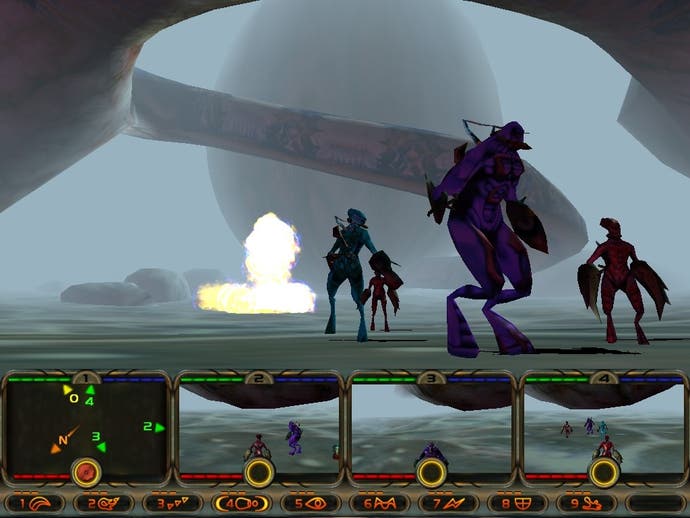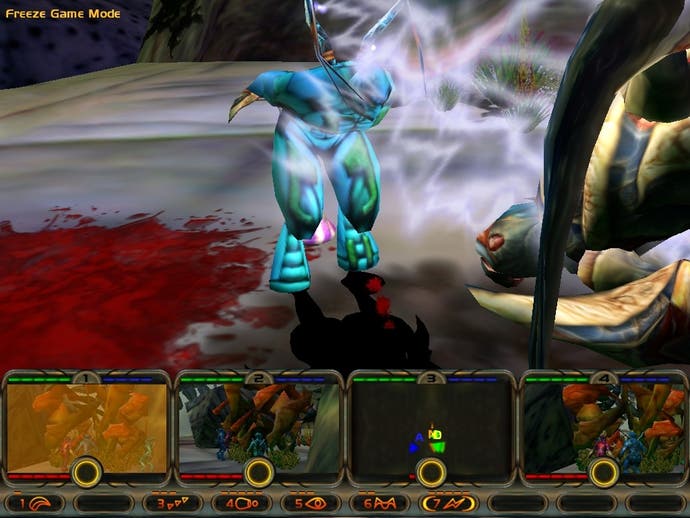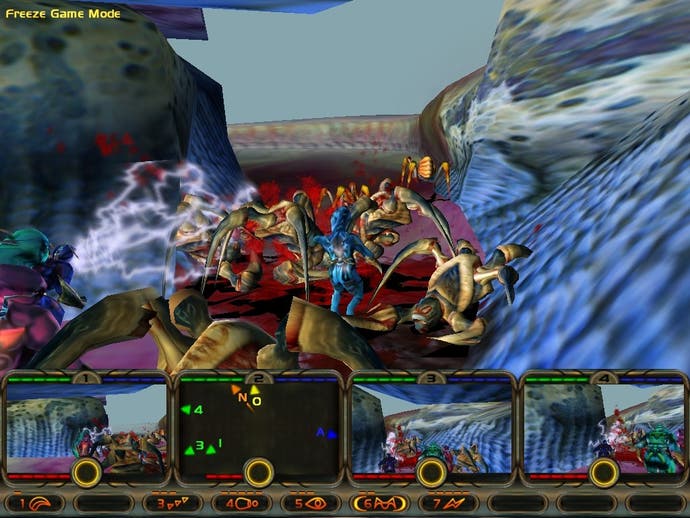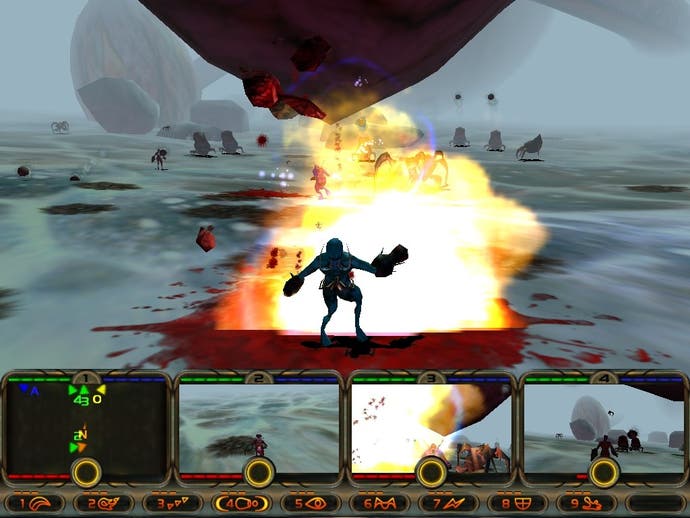Computer Artworks (Evolva)
Evolva team interviewed
Until recently British company Computer Artworks was probably best known for "Organic Art", a program which allows you to "evolve" art on your computer, picking out which strains you like best and breeding them to produce eerily beautiful pictures that look like some sort of bizarre prehistoric life form...
The programs have sold by the bucket-full, and have been used to create organic artwork for clothes, books, and cinema trailers, as well as producing the covers for The Shamen's "Axis Mutatis" album and Robert Miles' hit single "Children"!
Now they are hard at work putting the finishing touches to their first game, a third person action game called Evolva. We talked to Vince Farquharson (Producer), Rik Heywood (Lead Programmer) and Karl Wickens (Lead Artist) to find out more about the game and the company behind it...

Gene Splicing
"Computer Artworks was founded in 1993 by William Latham and Mark Atkinson with the aim of combining their interest and involvement with high tech and lush visuals into interactive products for the mass market", Vince told us.
"The aim was always to evolve the company to a point whereby the best games were being created, as well as more experimental interactive products."
"The first manifestation of these goals was the Organic Art screensaver and 3D scene creator which gave the company its first chance to flex its 3D muscle. This was revisited with the updated Organic Art Deluxe. These worked as useful stepping stones to build the company and technology to a stage where the very ambitious Evolva could be undertaken."
Ambitious is certainly the word for Evolva, which features some of the most jaw-dropping graphics yet seen in a computer game, with beautiful organic landscapes, believable alien creatures, and the ability to mutate your team of "genohunters" into an almost infinite array of different variations during the game.
According to Vince the team behind the game is a mix of "experienced game industry professionals, the original Organic Art team, and talented new comers", and the experience from the old Organic Art software has clearly carried over into Evolva. Its influence on the environments and creatures in Evolva, and particularly the genohunter mutation system, is obvious.

Genohunters
Evolva is certainly one of the more original games due for release this year, with the usual array of rocket launchers and big guns being replaced by organic weaponry like claws and fire breath.
"Evolva was inspired by many of the hot topics for the millennium such as cloning, genetic engineering and the genetically engineered food debate", Vince explained.
"It is our extrapolation of these ideas into a potential future scenario where the military has advanced these technologies for their own means. Man has created the ultimate warrior called the Genohunter."
"The Genohunter is able to mutate and adapt itself in any combat situation by absorbing the remains of defeated enemies and extracting any useful genes. It then modifies itself to incorporate these, [so] as the Genohunters move through the battlefield they become increasingly powerful in order to overcome their enemies."

Evolution
So how does this mutation system work in practice? Lead artist Karl Wickens filled us in on the details...
"As you progress through the game your Genohunters absorb the remains of their dead foes, [and] this provides you with a gene pool representing the abilities of the enemies. There are genes for the weapons (10 in all), the abilities, like speed and jump, and for the aesthetic look of your Genohunter."
"Whenever you mutate your Genohunter you're given two variants to pick from - each one will have slightly different weapons, stats, and physical appearance. Once one has been picked you can mutate that one, progressing further along a unique evolutionary path."
The possibilities are almost endless... "You might mutate 50 times in a level, so there are a vast number of unique Genohunter set-ups by the time you've reach the end of the game."
The literally millions of different variations that are possible means that the different geno types couldn't all be modelled and skinned in advance. Instead they are generated on the fly by the game as you mutate your characters.
"They have been built as a skin wrapped around a skeleton, with muscles which can have variable sizes, and even a fat layer. If you give your Genohunters just weapons and no speed or agility genes, they can get pretty fat indeed!"
"They also have places all over their bodies where spikes and other appendages can grow, [and] even the colour of their skin can shift throughout the game."

Genetic Engineering
Having generated these models and skins, they then have to be put into the game itself... That's lead programmer Rik Heywood's job, and he explained some of the tricks the game uses to produce the gorgeous visuals you can see in the screenshots.
"Evolva is able to dynamically adjust the level of detail in all the models in the game. We are not the first game to do this, but where we stand out from the crowd is just how high we can get the detail."
And how high is that? "On a PC that supports T&L hardware it is possible to get about 7,000 polygons per creature", Rik told us.
"With up to 25 creatures attacking you simultaneously we can really stretch these cards to their full potential - this is actually more polygons than we used when rendering the in game FMV sequences!"
"We also take full advantage of the hardware lighting support in these cards - fires flicker, arcs of electricity fill the caves with light and, occasionally, stealthed creatures can be detected by the faint glow that they leave behind them."
"And as the detail level goes up we find even more ways to enhance the environment. We have realistic shadows cast by all the creatures, and we can push the horizon back to give the player magnificent views of this strange alien world."
So if you have a GeForce 256 graphics card in your computer, this could be one of the first games to really push it to its limits - at high resolution with all the detail settings up on high the game looks truly incredible.
But even if you don't have tomorrow's technology, you aren't going to be left behind, as Rik explained. "If you don't have one of these amazing cards, then don't worry. Evolva is fully scalable and runs perfectly well on the original Voodoo 1, with higher levels of detail than you are probably used to seeing on machines with much higher spec hardware."

Artificial Life
Graphics aren't everything though, and according to Karl "one of the things which will make Evolva stand out is the AI of the creatures".
"Sometimes you'll turn a corner and be confronted by loads of aliens, you turn and run, and some of them will tear after you - no matter how far you run these creatures will track you across the whole map."
"Another great thing is that they will get angry with each other. I've been in battles where aliens have accidentally hit each other then started retaliating - these things are vicious!!!"
But Karl's favourite part of the game isn't the AI, or the graphics. "My favourite part of the game is mucus!"
Um .. mucus? Dare we ask?
"Spew a trail of sticky mucus across the landscape, wait for the unsuspecting bad guy to step in it (it slows him right down), then the best bit .. the mucus is flammable, so one quick burst with the flame breath and he's toast."
Mmm .. toast.

Multiplying
"Players get to control a team of Genohunters against a deadly alien parasite that is threatening our galaxy" in Evolva, and the mutation system means that there are an almost infinite variety of Genohunters possible.
As Vince told us, "by the end of the game players will have created a unique team" of Genohunters. But what to do with them once you have finished the single player game?
Well, the fun doesn't stop there, as players will be able to "email [their Genohunters] to friends, or go online to challenge other Evolva players and their unique creations". Which sounds like some kind of bizarre cross-breeding of Quake and Pokemon. We like it!
Rik explained how this will all work in practice...
"There are a large set of maps that have been specially designed just for multiplayer games, [varying] from quite small compact maps for one on one battles to huge maps with all manner of traps and tricks in them, for when you get a few more people involved."
"You control your team in the deathmatch arena just like you do in the single player game. You also get to take the Genohunters you have built up in the single player game into the deathmatch arena, to fight them against other players - you finally get to settle those arguments, about who has the best team by the end of level 5, once and for all :-)"
"Teams that perform well can be swapped and traded via email with your friends, allowing you to try out other peoples carefully nurtured Genohunters."
And as each player can "take anything from 1 Genohunter up to a full team of 4 Genohunters each into a game", you can work together with other players co-operatively. "It is great to have someone covering your back as you make a break for some valuable genes", Rik told us.

Conclusion
Vince told us that "the game has been in full development for two and a half years, with the team ramping up over that period", and if everything goes to plan it should be ready to release in April or May.
"The biggest challenge has been to deliver on all of the initial promises of the best gameplay married to the best technology and visuals", according to Vince. "We think we have done this, and the responses to date have been very positive."
Judging from what we've seen of the game so far, we're inclined to agree. Evolva is one of the best looking games we've played so far, and even the pre-beta version we were given to preview was great fun to play.
So what comes next for the Evolva team?
"There are some very exciting things in the pipeline for Computer Artworks, much of which I can't talk about yet. What I can say is that we will continue to push the areas we are already involved in, whilst always looking for exciting new territories to explore."
Do I hear Evolva Online? We'll just have to wait and see... Thanks to Vince Farquharson, Rik Heywood and Karl Wickens for answering our questions, and to Carolyn Seager for setting the interview up.
-

